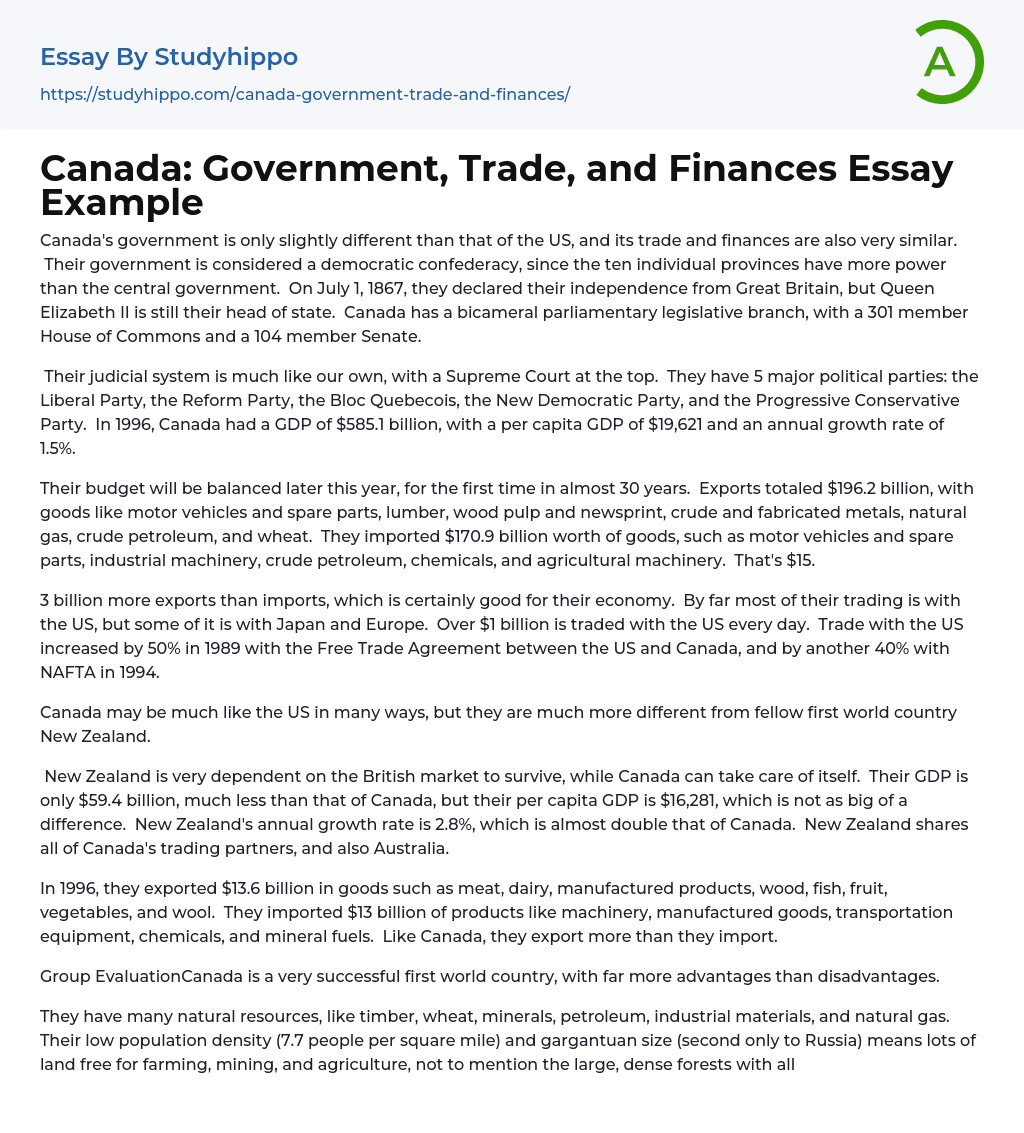Canada's government is only slightly different than that of the US, and its trade and finances are also very similar. Their government is considered a democratic confederacy, since the ten individual provinces have more power than the central government. On July 1, 1867, they declared their independence from Great Britain, but Queen Elizabeth II is still their head of state. Canada has a bicameral parliamentary legislative branch, with a 301 member House of Commons and a 104 member Senate.
Their judicial system is much like our own, with a Supreme Court at the top. They have 5 major political parties: the Liberal Party, the Reform Party, the Bloc Quebecois, the New Democratic Party, and the Progressive Conservative Party. In 1996, Canada had a GDP of $585.1 billion, with a per capita GDP of $19,621 and
...an annual growth rate of 1.5%.
Their budget will be balanced later this year, for the first time in almost 30 years. Exports totaled $196.2 billion, with goods like motor vehicles and spare parts, lumber, wood pulp and newsprint, crude and fabricated metals, natural gas, crude petroleum, and wheat. They imported $170.9 billion worth of goods, such as motor vehicles and spare parts, industrial machinery, crude petroleum, chemicals, and agricultural machinery. That's $15.
3 billion more exports than imports, which is certainly good for their economy. By far most of their trading is with the US, but some of it is with Japan and Europe. Over $1 billion is traded with the US every day. Trade with the US increased by 50% in 1989 with the Free Trade Agreement between the US and Canada, and by another 40% with
NAFTA in 1994.
Canada may be much like the US in many ways, but they are much more different from fellow first world country New Zealand.
New Zealand is very dependent on the British market to survive, while Canada can take care of itself. Their GDP is only $59.4 billion, much less than that of Canada, but their per capita GDP is $16,281, which is not as big of a difference. New Zealand's annual growth rate is 2.8%, which is almost double that of Canada. New Zealand shares all of Canada's trading partners, and also Australia.
In 1996, they exported $13.6 billion in goods such as meat, dairy, manufactured products, wood, fish, fruit, vegetables, and wool. They imported $13 billion of products like machinery, manufactured goods, transportation equipment, chemicals, and mineral fuels. Like Canada, they export more than they import.
Group EvaluationCanada is a very successful first world country, with far more advantages than disadvantages.
They have many natural resources, like timber, wheat, minerals, petroleum, industrial materials, and natural gas. Their low population density (7.7 people per square mile) and gargantuan size (second only to Russia) means lots of land free for farming, mining, and agriculture, not to mention the large, dense forests with all of their highly profitable lumber. Their GDP is quite high, with a respectable 1.
5% yearly growth. They export more than they import, as stated earlier. Canada is a member of NATO, OSCE, OAS, APEC, and NAFTA, as well as close friends with France. What may be Canada's biggest asset is its strong relationship with the US.
Many say that the US and Canada are friendlier than any other two nations in the
world. They trade with each other quite freely, and have the longest friendly border in the world.
Their unemployment rate is still high, but it is dropping, currently 8.6%, down from November's 9%. Canada's biggest disadvantage is its inner conflict between the French-speaking residents of Quebec, who call themselves the Quebecois, and the rest of the country.
Many Quebecois want to separate from the rest of the country, and have voted on this twice. The first time, in 1980, it was rejected by 20%, while recently in 1995 it only lost by .56%. The Quebecois want to hold another vote before the end of 1999, and since the last one was so close, there is a very strong possibility that Canada will become a nation divided.
Bibliography
- "Background Notes: Canada." SIRS Government Reporter, SIRS Inc., October 1998.
- "Canada's Fiscal Situation and Outlook - Budget Fact Sheet 1998." http://www.fin.gc.ca/budget98/facte/fiscfte.html"Canada's Strong Economy." http://www.cyberhaven.com/globalinvesting/canadaeconomy.html
- Money essays
- Financial Accounting essays
- Market Segmentation essays
- Supply And Demand essays
- Purchasing essays
- Forecasting essays
- Legacy essays
- Bank essays
- Corporate Finance essays
- Financial News essays
- Financial Ratios essays
- Financial Services essays
- Free Market essays
- Shareholder essays
- Personal finance essays
- Equity essays
- Financial Crisis essays
- Banking essays
- Credit Card essays
- Currency essays
- Debt essays
- Gold essays
- Loan essays
- Enron Scandal essays
- Foreign Exchange Market essays
- Investment essays
- Venture Capital essays
- Stock Market essays
- Retirement essays
- Donation essays
- Net Present Value essays
- Income Statement essays
- Commercial Bank essays
- Debit Card essays
- Deposit Account essays
- Subprime Lending essays
- Perfect Competition essays
- Underwriting essays
- Synergy essays
- Valuation essays
- Investing essays
- Asset essays
- Depreciation essays
- Discounted Cash Flow essays
- Foreign Direct Investment essays
- Funds essays
- Internal Rate Of Return essays
- Revenue essays
- Day Trading essays
- Futures Trading essays




